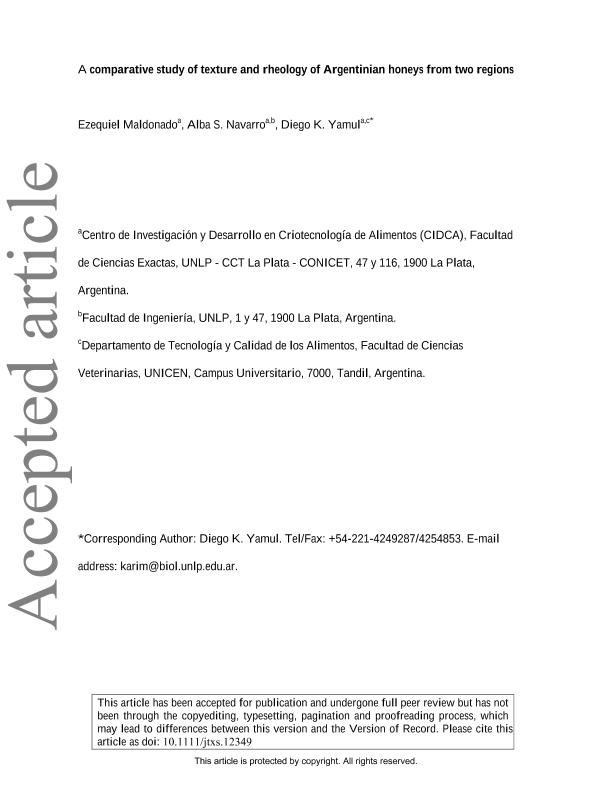Mostrar el registro sencillo del ítem
dc.contributor.author
Maldonado, Gerardo Ezequiel

dc.contributor.author
Navarro, Alba Sofia del Rosario

dc.contributor.author
Yamul, Diego Karim

dc.date.available
2019-10-30T15:01:21Z
dc.date.issued
2018-08
dc.identifier.citation
Maldonado, Gerardo Ezequiel; Navarro, Alba Sofia del Rosario; Yamul, Diego Karim; A comparative study of texture and rheology of Argentinian honeys from two regions; Wiley Blackwell Publishing, Inc; Journal Of Texture Studies; 49; 4; 8-2018; 424-433
dc.identifier.issn
0022-4901
dc.identifier.uri
http://hdl.handle.net/11336/87642
dc.description.abstract
The rheological and textural properties of 26 eastern Argentinian honeys from two different regions (North and Central) were investigated. The viscosity curves of the samples were obtained using a rotational rheometer over a temperature range of 10 to 50C. The viscosity decreased with temperature and all honeys showed a Newtonian behavior. The temperature dependence of viscosity was described using the Arrhenius, Williams–Landel–Ferry, Vogel–Taumman–Fulcher, and Power Law models. The glass transition temperatures of honeys were measured with differential scanning calorimetry and values ranged from −42.63 to −47.71C. The glass transition temperature was also predicted with the Williams–Landel–Ferry model and no significant differences were observed with the experimental results. Rheological parameters were obtained by small amplitude oscillation experiments. Results indicated that the viscous modulus was higher than the storage modulus within all the frequency ranges assayed and honeys from the North region were more viscous. Results of the back extrusion test showed that honeys from the Central region are harder and both groups of honeys (North and Central) exhibited the same consistency and adhesivity. Practical applications: The honey chain production starts with the extraction of the product from the combs, pumping it through pipes and finishes at the packaging of the product. During all these stages, honey viscosity is a key parameter to ensure proper processing and quality control, preventing the waste of economic resources. Determining honey viscosity is of great importance for the industry to select the equipment such as pumps, mixers, filters, centrifuges, heat exchangers, and optimization of industrial processes. The rheological and textural properties of honey are very important in terms of applications related to quality control and authenticity of honeys. Honey authenticity increases the trust of consumers to certified food products. Argentina is one of the leading honey producers and exporters in the world, but information on the rheological, thermal, and textural characteristics of Argentinian honey is very poor in the scientific literature.
dc.format
application/pdf
dc.language.iso
eng
dc.publisher
Wiley Blackwell Publishing, Inc

dc.rights
info:eu-repo/semantics/openAccess
dc.rights.uri
https://creativecommons.org/licenses/by-nc-sa/2.5/ar/
dc.subject
Honey
dc.subject
Rheology
dc.subject
Texture
dc.subject
Glass transition
dc.subject.classification
Alimentos y Bebidas

dc.subject.classification
Otras Ingenierías y Tecnologías

dc.subject.classification
INGENIERÍAS Y TECNOLOGÍAS

dc.subject.classification
Alimentos y Bebidas

dc.subject.classification
Otras Ingenierías y Tecnologías

dc.subject.classification
INGENIERÍAS Y TECNOLOGÍAS

dc.title
A comparative study of texture and rheology of Argentinian honeys from two regions
dc.type
info:eu-repo/semantics/article
dc.type
info:ar-repo/semantics/artículo
dc.type
info:eu-repo/semantics/publishedVersion
dc.date.updated
2019-10-15T14:12:17Z
dc.journal.volume
49
dc.journal.number
4
dc.journal.pagination
424-433
dc.journal.pais
Reino Unido

dc.journal.ciudad
Londres
dc.description.fil
Fil: Maldonado, Gerardo Ezequiel. Provincia de Buenos Aires. Gobernación. Comisión de Investigaciones Científicas. Centro de Investigación y Desarrollo en Criotecnología de Alimentos. Consejo Nacional de Investigaciones Científicas y Técnicas. Centro Científico Tecnológico Conicet - La Plata. Centro de Investigación y Desarrollo en Criotecnología de Alimentos. Universidad Nacional de la Plata. Facultad de Ciencias Exactas. Centro de Investigación y Desarrollo en Criotecnología de Alimentos; Argentina
dc.description.fil
Fil: Navarro, Alba Sofia del Rosario. Provincia de Buenos Aires. Gobernación. Comisión de Investigaciones Científicas. Centro de Investigación y Desarrollo en Criotecnología de Alimentos. Consejo Nacional de Investigaciones Científicas y Técnicas. Centro Científico Tecnológico Conicet - La Plata. Centro de Investigación y Desarrollo en Criotecnología de Alimentos. Universidad Nacional de la Plata. Facultad de Ciencias Exactas. Centro de Investigación y Desarrollo en Criotecnología de Alimentos; Argentina
dc.description.fil
Fil: Yamul, Diego Karim. Universidad Nacional del Centro de la Provincia de Buenos Aires. Facultad de Ciencias Veterinarias. Departamento de Tecnologia y Calidad de los Alimentos; Argentina
dc.journal.title
Journal Of Texture Studies

dc.relation.alternativeid
info:eu-repo/semantics/altIdentifier/url/http://doi.wiley.com/10.1111/jtxs.12349
dc.relation.alternativeid
info:eu-repo/semantics/altIdentifier/doi/https://doi.org/10.1111/jtxs.12349
Archivos asociados
